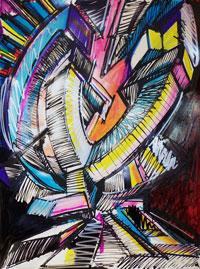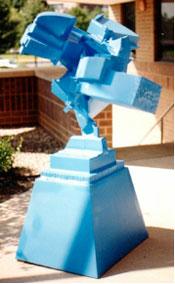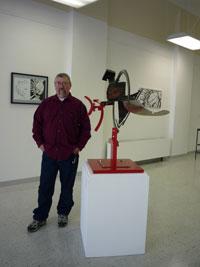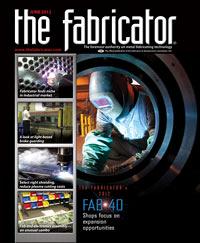- FMA
- The Fabricator
- FABTECH
- Canadian Metalworking
Categories
- Additive Manufacturing
- Aluminum Welding
- Arc Welding
- Assembly and Joining
- Automation and Robotics
- Bending and Forming
- Consumables
- Cutting and Weld Prep
- Electric Vehicles
- En Español
- Finishing
- Hydroforming
- Laser Cutting
- Laser Welding
- Machining
- Manufacturing Software
- Materials Handling
- Metals/Materials
- Oxyfuel Cutting
- Plasma Cutting
- Power Tools
- Punching and Other Holemaking
- Roll Forming
- Safety
- Sawing
- Shearing
- Shop Management
- Testing and Measuring
- Tube and Pipe Fabrication
- Tube and Pipe Production
- Waterjet Cutting
Industry Directory
Webcasts
Podcasts
FAB 40
Advertise
Subscribe
Account Login
Search
It starts with a sketch
Fabricator/sculptor derives third dimension from 2-D drawings
- By Eric Lundin
- June 8, 2012
- Article
- Shop Management

Fabricator and sculptor Philip Dees relies heavily on sketches before starting to create a piece in metal. The sketches often go through dozens of revisions before they are finished. “Exploding Mammoth Gear,” January 2009. Prismacolor® and marker on cartoon paper, 9 in. by 12 in. Collection of Michael and Susan Tingley. Photo courtesy of Philip Dees.
Whether he’s creating a piece of artwork, refurbishing his century-old house, or working up some other project, Philip Dees usually starts with a sketch. While some artists start with an idea in mind and pursue it more or less directly, Dees doesn’t. He sees sketching as a loosely defined way to explore an idea or a concept, which can lead to more sketches as he lets the idea change and evolve into dozens, if not hundreds, of possibilities. And while his first love is in two dimensions, he enjoys the challenge of turning 2-D concepts into 3-D sculptures.
The first big step in his career as an artist was earning a Bachelor of Arts degree from Southern Illinois University (Carbondale, Ill., Dees’ hometown), where he focused solely on drawing and painting. His second big step was getting a job to pay the bills. Luckily, Dees landed a job assembling flatbed trailers at Transcraft Corp., a job that expanded his skill set to include welding and fabrication, and taught him the intricacies of working in three dimensions (see Figure 1).
Meanwhile Dees explored sculpture with metals in his spare time. He didn’t have a studio, but got by fabricating on his parents’ patio. Two years later he embarked on a third big step: pursuing a Master of Fine Arts degree from Indiana State University with a major emphasis on sculpture and a minor in painting. He still works as a fabricator to pay the bills; still works for a trailer manufacturer (these days his employer is Great Dane, in Terre Haute, where Dees lives); and he still works from drawings, but completing an MFA has taken his work up a couple of notches.
Dees sees the act of sketching as a starting point, an evolving idea that has the essentials—line, shape, form, and color. Every sketch leads to a series of questions. Will this sketch lead to another? And another? Will it lead to a finished drawing? Will it become a scaled model? Will it be one of the few that becomes a life-sized sculpture? Will the finished piece hold greater meaning than the first kernel of a sketch?
Many of Dees’ sculptures reveal his love of industrial processes—cutting, measuring, clamping, drilling, welding, hammering, grinding, polishing, sanding, and painting. And even though many fabricating processes come easy after decades of experience, Dees is aware that many of the proc-esses require blood, sweat, and tears.
“It’s like pedaling a bicycle up a steep hill,” he said. “It’s difficult, and it can be grueling, but the thrill comes in seeing a job that turned out well, or going full-speed down the other side of the hill.”
A Flight of Fancy
A favorite series of Dees is called “Flight of Fancy” (see Figure 2).
“The inspiration for the ‘Flight of Fancy’ series is a recurring dream I have,” Dees said. “I believe many people have dreams of being able to fly.
Dees thinks that the weightless, effortless sensation shows up in many waking moments—riding his motorcycle on a twisting, turning road through hilly terrain and, closer to home, losing himself in his work in the studio.
“When I’m nearing the completion of a new drawing or sculpture and it sings, I get a similar feeling,” he said.

Figure 1: Strong geometric shapes characterize many of Dees’ sculptures. “Blue Sculpture” at ISU School of Technology.
Working at Home
One of Dees’ latest projects is refurbishing his home, which was built in 1907. He refers to the process of refurbishing the home as “House as Art,” which he has broken down into small projects such as Fence Project as Art.
“I like the idea of approaching other projects with the same creativity as I approach my art,” Dees said. “I don’t believe that creativity is something to be turned on when entering the studio and turned off when leaving the studio. I’m approaching the rebuilding of our house as one big sculpture project.”
After tearing off the front siding, insulating the exterior wall, and reinforcing it with plywood, Dees clad it in metal to match the newly added metal roof.
Meanwhile, an entirely new fence and gate have dressed up the yard substantially.
Dees has found that some portions of the House as Art project require two attempts. His original satellite dish tower, made from wood, warped and twisted as it weathered, so it’s due for replacement in a much more stable material—metal. Dees even sees some of the more mundane parts of a house, such as stairs, as an opportunity for artistic flair.
Continuing to Evolve
If you were to visit Dees during the fall or winter, you wouldn’t see too much fabricating activity. His shop isn’t heated, so he usually spends this time in the comfort of his drawing studio, creating image after image so he’s ready when warm weather arrives. Then he springs into action, armed with an inventory of drawings. And despite the care and effort that go into the drawings, many revised numerous times, Dees allows that they are open to further revision in the shop.
“Some works I might build closely aligned to the drawn image,” he said. “On others the drawing is a starting point, a springboard for creating something that departs from the image.”
About the Author

Eric Lundin
2135 Point Blvd
Elgin, IL 60123
815-227-8262
Eric Lundin worked on The Tube & Pipe Journal from 2000 to 2022.
subscribe now

The Fabricator is North America's leading magazine for the metal forming and fabricating industry. The magazine delivers the news, technical articles, and case histories that enable fabricators to do their jobs more efficiently. The Fabricator has served the industry since 1970.
start your free subscription- Stay connected from anywhere

Easily access valuable industry resources now with full access to the digital edition of The Fabricator.

Easily access valuable industry resources now with full access to the digital edition of The Welder.

Easily access valuable industry resources now with full access to the digital edition of The Tube and Pipe Journal.
- Podcasting
- Podcast:
- The Fabricator Podcast
- Published:
- 04/30/2024
- Running Time:
- 53:00
Seth Feldman of Iowa-based Wertzbaugher Services joins The Fabricator Podcast to offer his take as a Gen Zer...
- Industry Events
16th Annual Safety Conference
- April 30 - May 1, 2024
- Elgin,
Pipe and Tube Conference
- May 21 - 22, 2024
- Omaha, NE
World-Class Roll Forming Workshop
- June 5 - 6, 2024
- Louisville, KY
Advanced Laser Application Workshop
- June 25 - 27, 2024
- Novi, MI
































